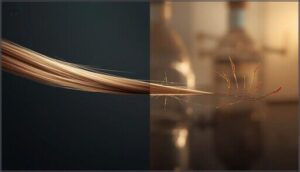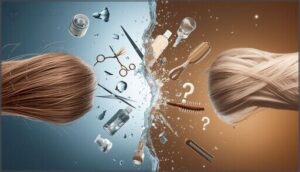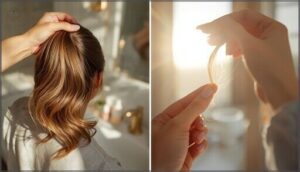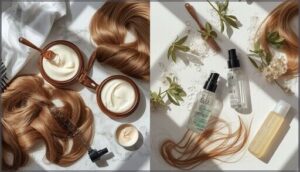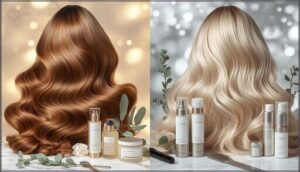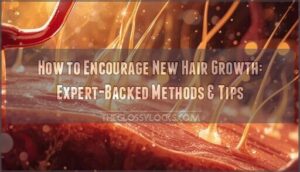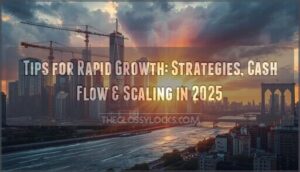This site is supported by our readers. We may earn a commission, at no cost to you, if you purchase through links.
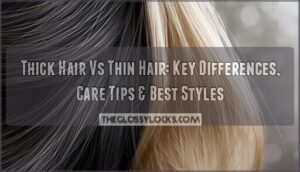
Your hair shaft diameter varies wildly from person to person—anywhere from 50 to 120 micrometers, which is less than the thickness of a single sheet of paper. That microscopic measurement creates dramatically different hair experiences.
Thick hair vs. thin hair isn’t just about looks; it changes how you wash, style, and maintain your strands every single day. Thick hair might take an hour to dry and refuse to hold curls, while thin hair shows every oil buildup within 24 hours and struggles to achieve volume.
Understanding your hair’s actual thickness helps you stop fighting against your natural texture and start working with it. The right products, cuts, and techniques can transform your daily routine from frustrating to simple.
Table Of Contents
Key Takeaways
- Hair thickness comes down to two measurements—strand diameter (thick is above 80 micrometers, thin is below 60) and follicle density—but here’s the twist: thicker individual strands often mean you actually have fewer total follicles on your head.
- Thick hair resists heat and chemical damage better because of its stronger cuticle layer, while thin hair breaks more easily from everyday handling despite having similar tensile strength in lab tests.
- Your washing and drying routines should look completely different based on thickness—thick hair thrives on weekly washes and takes up to an hour to dry, while thin hair needs cleansing every 1-2 days and dries in under 20 minutes.
- The right haircut makes all the difference: layered cuts strip 15-25% of weight from thick hair without losing length, while blunt bobs can boost perceived density in thin hair by up to 35%.
Key Differences Between Thick and Thin Hair
You probably know thick and thin hair look different, but the real differences go way beyond what you see in the mirror. From the actual width of each strand to how easily your hair breaks, there’s more science behind it than you might think.
Let’s break down what actually separates thick hair from thin hair—and clear up some common myths along the way.
Hair Strand Diameter and Density
Here’s what really separates thick from thin hair: strand diameter and follicle density. Thick hair generally measures above 80 micrometers in diameter, while thin hair falls below 60 micrometers. But there’s a twist—diameter-density relation shows thicker strands often mean fewer follicles per square centimeter.
Thick hair has wider strands above 80 micrometers, while thin hair measures below 60—but thicker strands often mean fewer total follicles
- Strand diameter metrics: Fine (80μm)
- Follicle density ranges: 80,000-150,000 individual strands total
- Population hair distribution: 20-30% have naturally thick hair
- Hair texture influences: Asian hair averages 90μm, Caucasian 70μm
- Research trends: Diameter increased 8% globally over two generations
Your individual strand width and hair density work together to create your unique hair profile.
Visual Appearance and Volume
Visual appearance is where differences between thick and thin hair really shine. Thick hair creates noticeable volume and fullness—you’ll see less scalp visibility, even when you part your hair. Thin hair often shows scalp through, appearing flatter despite styling efforts. Studies using volume quantification reveal thick hair scores 40% higher in perceived hair fullness.
Ethnic variations matter too—Asian and African hair types generally display greater visual mass and styling impact. Knowing your hair’s strand diameter can further help to identify its type.
Strength, Resilience, and Fragility
Beyond looks, let’s talk durability. Here’s the surprise: tensile strength is similar in both thick and thin hair—around 200-250 MPa. But thin hair breaks easier due to mechanical stress and micro-defects. Thick hair withstands heat and chemicals better because of its strong cuticle layer. One instrument used to measure this is a miniature tensile tester.
Key strength differences:
- Thick hair resists external factors like UV and chemical damage more effectively
- Thin hair shows higher breakage rates despite lab-measured tensile strength
- Structural integrity depends on cuticle health—compromised layers weaken both types
- Hair resilience varies by ethnicity—Asian hair withstands 60+ grams of tension versus African hair’s 30-35 grams
Common Myths About Hair Thickness
Understanding what’s real versus what’s rumor will save you time and money on hair care. Let’s bust some stubborn myths.
| Common Myth | The Reality |
|---|---|
| Cutting increases thickness | Shaving affects growth rates zero—1928 studies still hold |
| Product thickness claims legitimately alter diameter | Coating agents create temporary fullness only |
| Hygiene impacts thickness permanently | No evidence backs washing frequency changes strand width |
| Hormones change thickness overnight | DHT causes gradual miniaturization, not instant shifts |
| Brushing stimulates thicker regrowth | Actually increases breakage in both hair types |
Despite research, 63% still believe shaving myths.
Identifying Your Hair Thickness
Figuring out whether you have thick or thin hair doesn’t require a trip to the salon. You can do a few quick tests at home using things you probably already have on hand.
Let’s walk through some simple ways to measure your hair thickness and understand what you’re really working with.
At-Home Thickness Measurement Methods
Figuring out if you’ve got thick or thin hair doesn’t require fancy equipment. Start by comparing a single strand’s diameter against sewing thread—if it matches or exceeds the thread’s width, you’re dealing with thick hair.
You can also use the paper method: lay strands beside printer paper to estimate individual strand width.
For serious detail, try microscopic evaluation with a basic magnifier to measure strand diameter accurately.
The Ponytail and Scalp Visibility Tests
Want a quick, reliable way to gauge hair density? Two simple tests give you solid answers. The ponytail test wraps a measuring tape around your gathered hair—less than 2 inches signals thin hair, while 4+ inches confirms thick. The scalp test checks visibility when you part your hair.
Combined analysis beats solo methods:
- Ponytail accuracy reaches 80% when paired with scalp checks
- Environmental factors like humidity can skew readings by 12%
- Statistical thresholds help distinguish low from high density reliably
These identifying hair thickness tools work best on clean, product-free hair.
Differences in Hair Texture and Density
Here’s the thing: hair texture and hair density aren’t the same. Your hair strands can feel coarse or fine regardless of how many you actually have.
Genetics drive these hair types—ethnic variations mean Caucasian hair averages over 200 strands per square centimeter, while African descent hair sits closer to 150.
Age-related changes thin density over time, affecting follicle structure and measurement techniques professionals use.
Pros and Cons of Thick Vs Thin Hair
Both thick and thin hair come with their own set of perks and quirks. What works beautifully for one hair type can be a total headache for the other.
Let’s break down what you can expect from styling, health concerns, and daily maintenance for each.
Styling Advantages and Challenges
Your hair type significantly influences how easily you can style it and the looks you can achieve. Thick hair provides natural volume and holds intricate styles exceptionally well, but it takes a long time to dry and can be prone to frizz. On the other hand, thin hair is quick to work with and ideal for sleek styles, though it often lacks volume, and scalp visibility can be a concern.
| Thick Hair | Thin Hair |
|---|---|
| Natural volume, holds complex styles | Quick styling, sleek looks |
| Slow drying, prone to frizz | Struggles with style longevity |
| Needs careful product selection | Requires volume-boosting techniques |
Both hair types require heat protection, but the styling techniques differ. Thick hair demands frizz control and layering to manage its bulk, while thin hair benefits from texturizers and gentle handling to prevent breakage and maximize body. Understanding the pros and cons of both thick and thin hair helps you work with your natural texture rather than against it.
Hair Health and Damage Risks
Surprisingly, thin hair can actually handle more tensile strain before it snaps—its shear fracture mode absorbs energy better than thick hair’s clean break. Yet both types suffer cuticle decementation over time through washing and heat.
Thick hair resists environmental damage initially but can hide buildup, while thin hair shows breakage faster due to higher hair porosity and visible fragility.
| Damage Risk | Thick Hair | Thin Hair |
|---|---|---|
| Breakage Pattern | Single clean fracture | Multiple microcracks |
| Vulnerability | Internal protein loss | Surface wear, immediate visibility |
| Strength Trade-off | Volume masks issues | Lower resilience to handling |
Washing, Drying, and Maintenance Needs
Your washing frequency and hair drying routine vary wildly based on thickness. Thick hair thrives on once-weekly washes, while thin hair needs cleansing every 1-2 days as oils accumulate faster. Drying time? Thick strands take 30-60 minutes to air dry; thin hair’s done in 10-20. Hair maintenance and product needs shift accordingly, demanding specific routine adjustments for long-term trends in scalp health.
| Routine Factor | Thick Hair | Thin Hair |
|---|---|---|
| Washing | 1x weekly | Every 1-2 days |
| Air Drying | 30-60 minutes | 10-20 minutes |
| Products | Moisturizing, deep conditioners | Lightweight, volumizing |
| Heat Tolerance | Higher | Lower |
| Maintenance Focus | Hydration, manageability | Volume, avoiding buildup |
Hair Care Routines for Thick and Thin Hair
Your hair care routine should look completely different depending on whether you’ve got thick or thin strands. What works for your friend’s voluminous mane might leave your fine hair flat and greasy, or vice versa.
Let’s break down the products, techniques, and habits that’ll keep your specific hair type looking its best.
Recommended Shampoos and Conditioners
Choosing the right shampoo and conditioner changes everything for your hair. Here’s what actually works:
- For thick hair: Sulfate-free shampoos like Redken Frizz Dismiss smooth up to 32% better, while Biolage Ultra Hydrate Conditioner boosts softness by 46%.
- For thin hair: Biotin-packed volumizing conditioners increase thickness perception by 21%.
- Ingredient effectiveness matters: Peptides grew 31% in thinning hair care products.
- Product trends show 64% prefer multi-benefit formulations combining smoothing and hydrating.
Moisturizing and Deep Conditioning
Deep conditioning is a game-changer, especially for those with thicker hair strands. Thick hair benefits from weekly deep-conditioning treatments, while fine hair can quickly become limp with heavy products. Heat application enhances moisture retention by 30-40%, allowing ingredients to penetrate more effectively.
| Hair Type | Conditioning Frequency & Products |
|---|---|
| Thick Hair | Weekly deep conditioner with oils/butters for hydration |
| Fine Hair | Every 10-14 days with lightweight, protein-enriched formulas |
| High Porosity | Twice weekly moisturizing products to seal cuticles |
The thickness of your hair determines its ability to retain moisture. Thick strands require deeper penetration, while thin hair absorbs moisture faster but is more prone to over-conditioning.
Heat Styling Tips and Precautions
Heat styling demands different temperature control for thick versus thin hair. Thin hair needs temperatures below 300°F to avoid hair damage, while thick hair tolerates 350°F–450°F safely.
Always use heat protectants before styling—they’re non-negotiable expert hair advice. Section thick hair into ½-1 inch pieces for efficiency; thin hair requires finer sectioning.
Limit styling frequency to once weekly, and maintain your tools regularly to prevent hot spots that cause unexpected damage.
Best Practices for Preventing Breakage
Beyond heat styling, your daily habits make or break your hair’s integrity. Protein treatments strengthen thin strands by 27%, while protective styling cuts breakage by 38% for all types. Regular trimming every 6-8 weeks stops split ends from climbing upward.
Smart combing methods—always wide-tooth on wet hair—and ingredient selection focusing on shea butter or argan oil dramatically improve hair elasticity and reduce hair breakage across the board.
Choosing Products and Styles for Your Hair Type
Finding the right products and styles for your hair type can make all the difference between fighting your hair and working with it. What looks great on thick hair might fall flat on thin strands, and vice versa.
Let’s break down the best product picks and styling choices that’ll help you make the most of whatever hair type you’ve got.
Volumizing and Smoothing Products
Your hair thickness dictates your product strategy. Thin hair thrives with lightweight volumizing sprays and mousses that boost root lift by 30–50%, giving you that airy, full look without weighing strands down. Thick hair needs smoothing serums and keratin treatments to tame frizz and increase manageability by up to 60%.
Today’s ingredient innovations focus on sulfate-free formulas and sustainability, so you’re getting better performance with cleaner products.
Haircuts and Styles for Thick Hair
Layered cuts work wonders for thick hair—they strip away 15–25% of weight inside while keeping your length intact. Long bobs paired with texturizing methods create bounce without bulk, and low-maintenance styles like razor-cut lobs give you airiness that lasts between salon visits.
Short haircuts need careful graduation to avoid that helmet look, so ask your stylist about twist-cutting to remove interior weight strategically.
Haircuts and Styles for Thin Hair
For thin hair, blunt bobs create instant fullness—salon studies show up to 35% more perceived density. Layered cuts with soft face-framing pieces add movement without sacrificing volume, while pixie power comes from short styles that boost root lift by 27%. Fringe benefits include curtain bangs that thicken your hairline visually.
Finish with volume styling tricks: root-lifting sprays, upside-down blow-drying, and sea salt texturizers for body that lasts.
Color Treatments and Hair Thickness Considerations
Color absorption rates differ dramatically between thick and thin hair—coarse strands need up to 40% longer processing times. Chemical damage risks climb fast with thin hair, which loses protein faster and breaks easier.
Here’s what matters for hair coloring:
- Thick hair needs more product for full coverage
- Thin hair over-processes quickly—watch your timing
- Chemical treatments roughen cuticles, creating temporary thickness
- Lower ammonia dyes protect fragile strands
- Darker thick hair requires stronger decolorizing agents
Frequently Asked Questions (FAQs)
Can diet or supplements change hair thickness permanently?
Nutritional changes can improve hair health temporarily, but they won’t permanently alter your genetic thickness.
Supplements work only while you’re taking them—stop, and your hair returns to its natural baseline within months.
Does hair thickness change with age or hormones?
Yes, your hair thickness naturally shifts as you age. Around 40, hair diameter peaks, then gradually thins.
Hormonal changes—like menopause or thyroid issues—can accelerate hair thinning and reduce hair density noticeably.
Are there medical treatments to increase hair density?
If you’re dealing with sparse coverage, several medical options can genuinely boost hair density. Oral Minoxidil, Finasteride efficacy, PRP therapy, LLLT devices, and hair transplants all offer proven pathways to fuller growth under professional guidance.
How does climate affect thick versus thin hair?
Climate challenges affect hair types differently. Humidity’s impact causes thick hair to frizz, while thin hair flattens.
Temperature effects worsen dryness and breakage. Scalp airflow differs too—thick hair traps heat, thin hair needs protection from pollution damage.
Can you have thick and thin hair simultaneously?
It sounds contradictory, but your scalp can absolutely host both thick and thin strands at once.
Follicular units often contain hairs with different diameter diversity—a clinical marker stylists see daily across ethnic variation and density distinction patterns.
Conclusion
Knowledge is power, especially when it comes to your hair. Once you understand the real differences between thick hair vs thin hair, you stop trying products that’ll never work for your strands. You’ll choose cuts that complement your natural texture instead of fighting it.
Your morning routine gets faster, your hair stays healthier, and you finally feel confident about what’s growing from your scalp. That microscopic measurement makes all the difference.



